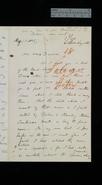CL would like to put Joachim Barrande on the Royal Society’s foreign list. Of French geologists and palaeontologists, he is the man who has made the greatest sacrifices and produced the greatest results.
Urges CD to publish his theory with small part of data.
Corrects names of land shells on list of shells picked up at Down.
Discusses transport of Ancylus from one river-bed to another by water-beetle.
"I hear that when you & Hooker & Huxley & Wollaston got together you made light of all Species & grew more & more unorthodox."
Mentions discussion of old Atlantis by Oswald Heer.
Comments on Helix and Nanina.
Mentions beetle discovered with small bag of eggs of water-spider under wing.
Madeira evidence favours single species birth-place theory.
CD forgets an author [CD himself in Coral reefs] "who, by means of atolls, contrived to submerge archipelagoes (or continents?), the mountains of which must originally have differed from each other in height 8,000 (or 10,000?) feet".
CL begins to think that all continents and oceans are chiefly post-Eocene, but he admits that it is questionable how far one is at liberty to call up continents "to convey a Helix from the United States to Europe in Miocene or Pliocene periods".
Will CD explain why the land and marine shells of Porto Santo and Madeira differ while the plants so nearly agree?
To cast doubt on CD’s view that volcanic action is associated with elevation of land, CL suggests that local oscillations in strata underlying volcanoes could also explain how active volcanoes have uplifted fossil deposits of marine shells. Overall he is more inclined to believe that recent volcanoes belong to areas of subsidence rather than of elevation.
Enumerates fossil mammals known in Secondary strata.
Lack of angiosperm plants in rocks older than Chalk is no reason to anticipate rarity of warm-blooded quadrupeds.
Praises the Origin: a "splendid case of close reasoning".
Objects to CD’s having ignored Lamarck and Geoffroy Saint-Hilaire.
Thinks CD should omit mentioning problem of explaining the eye at the beginning of chapter 14. Suggests rewording several passages.
Thinks want of peculiar birds in Madeira a difficulty, considering presence of them in Galapagos.
Has always felt that the case of man and his races is one and the same with animals and plants.
Wishes CD would enlarge on the doctrines of [Pyotr Simon] Pallas about the various races of dogs having come from several distinct wild species or sub-species.
Suggests organisms have a latent principle of improvement which is brought out by selection or breeding.
Since dogs have same gestation period as the wolf it is likely that the wolf is the ancestral wild species, if it is just one species.
CD’s belief that domestic dogs are descended from several distinct aboriginal species seems to contradict views on sterility of hybrids and variation in Origin. If domestic varieties came from hybrids of wild species it will be impossible to trace ancestry. Opponents will exploit these problems.
Questions CD’s view in Origin that domestic dogs are not descended from a single stock. Occasional crossings of domestic stock with wild species could explain cases of reversion towards wild specific forms. CD’s views on hybridity do not then have to be contradicted in constructing an ancestral stock.
Comments on pp. 201, 211, and 218 [of Origin].
Response to Origin. Praise for summary of chapter 10 and chapter 11.
The dissimilarity of African and American species is ‘necessary result of “Creation” adapting new species to the pre-existing ones. Granting this unknown & if you please miraculous power acting’.
C. T. Gaudin writes of Oswald Heer’s finding many species common between Miocene floras of Iceland and Switzerland. Interesting for CD’s migration theory.
Discusses CL’s paper, "On craters of denudation" [Q. J. Geol. Soc. Lond. 6 (1850): 207–34], which "will be a thorn in the side of É[lie] de B[eaumont]". Notes evidence from Galapagos overlooked by CL. Mentions other examples of craters.
Comments on CL’s Anniversary address [Q. J. Geol. Soc. Lond. 6 (1850): xxvii–lxvi]. Notes CL’s criticism of R. I. Murchison’s catastrophism.
Asks whether there are Lower Cretaceous beds in Scandinavia. Thinks Leopold von Buch must have neglected them.
Discusses depths at which ripple-marks appear on sea-floor.
Personal and social comment.
Mentions receiving Agassiz’s Lake Superior [1850].
Detailed critique of CL’s A manual of elementary geology [3d ed. (1851), used in editing 4th ed. (1852)].
Returns Lake Superior [1850], which he already has received from Agassiz. Thanks for pamphlets by C. B. Adams [on Mollusca, Contrib. Conchol. 10 (1851): 189–206; 11 (1852): 207–15].
Describes his dissection of an unusual cirripede [Alcippe lampas] with 12 males attached [see Living Cirripedia 2: 556, 558].
Volcanic activity of Mt Kilauea as described by Dana [Am. J. Sci. 2d ser. 9 (1850): 347–64]. Discusses the mechanics of volcanic eruption. Disputes view of William Hopkins that simultaneous action by volcanoes of different heights must come from separate lava sources. Notes relationship of continental elevation to volcanic action.
Describes meeting of Geological Society [1 June 1853].
Mentions his criticism of Murchison’s lecture on flints.
Describes Robert Chambers’ "On the glacial phenomena in Scotland" [Edinburgh New Philos. J. 54 (1853): 229–82].
Mentions controversial election of members to the Royal Society.
Comments on CL’s plan to visit Tenerife.
Discusses inclination of strata on islands and around mountains.
Personal affairs of several scientists.
Visit by Henslow.
Notes publication by Hooker [Himalayan journals (1854)].
Discusses views of Daniel Sharpe on foliation and cleavage. Recalls his own previous discussion [in South America].



